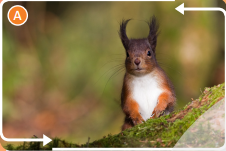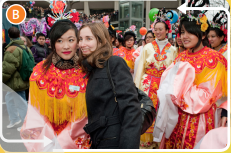Tiếng Anh 7 Unit 4 Vocabulary and Listening
THINK! What photographs do you prefer: people, places or sport? Why? 1. Read the texts and choose the correct words. Listen and check. 2. Complete the table with the adjectives and adverbs in exercise 1. 3. Listen to a photographer explaining how he took these photos. Put photos A–D in the order you hear. 4. Listen again and answer the questions. 5. USE IT! Work in pairs. Say how you can do the activities in the box. Use adverbs from exercise 2.
Tổng hợp đề thi học kì 1 lớp 7 tất cả các môn - Chân trời sáng tạo
Toán - Văn - Anh - Khoa học tự nhiên...
THINK!
THINK! What photographs do you prefer: people, places or sport? Why?
(SUY NGHĨ! Bạn thích những bức ảnh nào hơn: con người, địa điểm hay thể thao? Tại sao?)
Lời giải chi tiết:
I prefer the photographs of placesbecause they are beautiful and easy to take.
(Tôi thích những bức ảnh chụp địa điểm hơn vì chúng đẹp và dễ chụp.)
Bài 1
1. Read the texts and choose the correct words. Listen and check.
(Đọc văn bản và chọn các từ đúng. Nghe và kiểm tra.)
How to take better photos
It isn’t (1) easy / brave to photograph wild animals because they are (2) slow / fast. You need to be very (3) happy / patient. Find a (4) comfortable / careful place and sit (5) badly / quietly.
Remember, it’s (6) polite / rude to take photos of people you don’t know. Most people will (7) happily / rudely say yes if you ask (8) politely / well for permission.
When people are doing sports, they don’t move (9) slowly / patiently, so choose (10) carefully / bravely where you stand. For dangerous sports, the photographer needs to be (11) creative / slow and good at the sport, too.
Holiday photos are often (12) bad / slow, so if you want to take a (13) good / quiet photo, think (14) creatively / comfortably and choose unusual angles.
Lời giải chi tiết:
1. easy (dễ dàng)
2. fast (nhanh)
3. patient (kiên nhẫn)
4. comfortable (thoải mái)
5. quietly(yên tĩnh)
6. rude (thô lỗ, mất lịch sự)
7. happily (1 cách vui vẻ)
8. politely (1 cách lịch sự)
9. slowly(chậm)
10. carefully (cẩn thận)
11. creative (sáng tạo)
12. bad (xấu)
13. good (đẹp)
14. creatively (sáng tạo)
How to take better photos
It isn’t easy to photograph wild animals because they are fast. You need to be very patient. Find a comfortable place and sit quietly.
Remember, it’s rude to take photos of people you don’t know. Most people will happily say yes if you ask politely for permission.
When people are doing sports, they don’t move slowly, so choose carefully where you stand. For dangerous sports, the photographer needs to be creative and good at the sport, too.
Holiday photos are often bad, so if you want to take a good photo, think creatively and choose unusual angles.
Tạm dịch:
Cách chụp ảnh đẹp hơn
Không dễ để chụp ảnh động vật hoang dã vì chúng rất nhanh. Bạn cần phải rất kiên nhẫn. Tìm một nơi thoải mái và ngồi yên tĩnh.
Hãy nhớ rằng việc chụp ảnh những người bạn không quen biết là điều bất lịch sự. Hầu hết mọi người sẽ vui vẻ nói có nếu bạn xin phép một cách lịch sự.
Khi mọi người tập thể thao, họ không di chuyển chậm, vì vậy hãy chọn vị trí bạn đứng cẩn thận. Đối với những môn thể thao nguy hiểm, người chụp cần phải sáng tạo và giỏi môn thể thao đó.
Những bức ảnh ngày lễ thường rất xấu, vì vậy nếu bạn muốn chụp một bức ảnh đẹp, hãy suy nghĩ sáng tạo và chọn những góc chụp khác lạ.
Bài 2
2. Complete the table with the adjectives and adverbs in exercise 1.
(Hoàn thành bảng với các tính từ và trạng từ trong bài tập 1.)
|
Adjectives |
Adverbs |
|
bad |
badly |
Lời giải chi tiết:
|
Adjectives (tính từ) |
Adverbs (trạng từ) |
|
bad (xấu) fast (nhanh) patient (kiên nhẫn) comfortable (thoải mái) quiet (yên tĩnh) rude (bất lịch sự) happy (vui vẻ) polite (lịch sự) slow (chậm) careful (cẩn thận) creative (sáng tạo) good (đẹp) |
badly (1 cách xấu xí, tệ hại) fast (1 cách nhanh nhẹn) patiently (1 cách kiên nhẫn) comfortably (1 cách thoải mái) quietly (1 cách yên tĩnh) rudely (1 cách thô lỗ) happily (1 cách vui vẻ) politely (1 cách lịch sự) slowly (1 cách chậm chạp) carefully (1 cách cẩn thận) creatively (1 cách sáng tạo) well (1 cách tốt đẹp) |
Bài 3
3. Listen to a photographer explaining how he took these photos. Put photos A–D in the order you hear.
(Hãy nghe một nhiếp ảnh gia giải thích cách anh ấy chụp những bức ảnh này. Đặt ảnh A – D theo thứ tự mà bạn nghe thấy.)




Phương pháp giải:
Bài nghe:
Interviewer: How did you take this one, Steve?
Steve: Well, taking photos of animals isn't easy because they're fast and never stay in one place. For this photo I waited patiently for about an hour. I saw this squirrel while I was photographing flowers in a park. It was running up and down the tree and eating nuts. I was lying down when I took this photo.
Interviewer: I can see you were very close to it.
Steve: Yes. I was very quiet and it came quite close. It's often difficult to get close to animals because they're scared. So I often use a special camera and take photos from a distance.
Interviewer: Were you skiing when you took this photo?
Steve: Yes, I was. I was skiing with the guy in the photo. I was on his left when I took it.
Interviewer: That's very brave of you!
Steve: Not really. I can ski well. Some photographers do dangerous things. But I only take photos of sports I can do. If you follow simple rules, it isn't difficult to take good sports photos. The most important thing is to be in the right place at the right time.
Interviewer: This is a great photo!
Steve: Yes, it is. I was travelling in Asia when my friend and I saw this street parade. The women were wearing traditional clothes. We talked for a few minutes and then I asked if I could take their photograph with my friend. They said OK.
Interviewer: Do you always ask people for permission?
Steve: Yes. It's rude to take photos of people you don't know. Most people are happy for you to take their photo if you're friendly. If they say no, then you don't take the photo.
Interviewer: Where were you sitting when you took this photo?
Steve: I was sitting at the end of the boat and my three friends were at the other end. We were on holiday last summer. Holiday photos are often boring so I was trying new ideas. I took a lot of photos of my friends on the boat and in the sea that day. It was good fun!
Interviewer: Well, thanks Steve.
Tạm dịch:
Người phỏng vấn: Làm thế nào bạn chụp được ảnh này, Steve?
Steve: Chà, chụp ảnh động vật không dễ vì chúng rất nhanh và không bao giờ ở yên một chỗ. Để có bức ảnh này, tôi đã kiên nhẫn chờ đợi trong khoảng một giờ. Tôi nhìn thấy con sóc này khi đang chụp hoa trong công viên. Nó đang chạy lên chạy xuống cây và ăn hạt. Tôi đã nằm xuống khi tôi chụp bức ảnh này.
Người phỏng vấn: Tôi có thể thấy bạn đã rất gần với nó.
Steve: Vâng. Tôi đã rất yên lặng và nó đã đến khá gần. Rất khó để đến gần động vật vì chúng sợ hãi. Vì vậy, tôi thường sử dụng một chiếc máy ảnh đặc biệt và chụp ảnh từ xa.
Người phỏng vấn: Bạn đang trượt tuyết khi chụp bức ảnh này à?
Steve: Vâng. Tôi đang trượt tuyết với anh chàng trong ảnh. Tôi đã ở bên trái của anh ấy khi tôi chụp bức ảnh này.
Người phỏng vấn: Bạn thật dũng cảm!
Steve: Không hẳn. Tôi có thể trượt tuyết tốt. Một số nhiếp ảnh gia làm những việc nguy hiểm. Nhưng tôi chỉ chụp ảnh những môn thể thao mà tôi có thể chơi được. Nếu bạn tuân theo các quy tắc đơn giản, sẽ không khó để chụp được những bức ảnh thể thao đẹp. Điều quan trọng nhất là ở đúng nơi, đúng thời điểm.
Người phỏng vấn: Đây là một bức ảnh tuyệt vời!
Steve: Vâng, đúng vậy. Tôi đang đi du lịch ở châu Á thì tôi và bạn tôi nhìn thấy cuộc diễu hành đường phố này. Những người phụ nữ mặc trang phục truyền thống. Chúng tôi nói chuyện trong vài phút và sau đó tôi hỏi liệu tôi có thể chụp ảnh họ với bạn tôi không. Họ nói được.
Người phỏng vấn: Bạn có luôn xin phép mọi người không?
Steve: Có chứ. Thật thô lỗ khi chụp ảnh những người mà bạn không biết. Hầu hết mọi người đều vui vẻ cho bạn chụp ảnh nếu bạn thân thiện. Nếu họ nói không, thì bạn không chụp ảnh.
Người phỏng vấn: Bạn đã ngồi ở đâu khi chụp bức ảnh này?
Steve: Tôi đang ngồi ở cuối thuyền và ba người bạn của tôi ở đầu kia. Chúng tôi đã đi nghỉ mát vào mùa hè năm ngoái. Những bức ảnh ngày lễ thường nhàm chán nên tôi đã thử những ý tưởng mới. Tôi đã chụp rất nhiều ảnh của những người bạn của tôi trên thuyền và trên biển ngày hôm đó. Điều đó thật vui!
Người phỏng vấn: Vâng, cảm ơn Steve.
Lời giải chi tiết:
| 1. A | 2. C | 3. B | 4. D |
Bài 4
4. Listen again and answer the questions.
(Nghe lại lần nữa và trả lời câu hỏi.)
1 What was the squirrel doing in photo A?
(Con sóc đang làm gì trong bức ảnh A?)
2 In photo B, why was the photographer in Asia?
(Trong bức ảnh B, tại sao nhiếp ảnh gia ở châu Á?)
3 In photo C, was the photographer skiing?
(Trong bức ảnh C, nhiếp ảnh gia có đang trượt tuyết không?)
4 Where was the photographer in photo C?
(Nhiếp ảnh gia ở bức ảnh C ở đâu?)
5 In photo D, was the photographer standing in the boat?
(Trong bức ảnh D, nhiếp ảnh gia có phải đang đứng trên thuyền không?)
Lời giải chi tiết:
1. It was running up and down the tree and eating nuts.
(Nó chạy lên chạy xuống cây và ăn hạt.)
2. He was travelling.
(Anh ấy đang đi du lịch.)
3. Yes, he was.
(Đúng vậy.)
4. He was on the person's left.
(Anh ấy ở bên trái người đó.)
5. No, he was sitting in the boat.
(Không, anh ấy đang ngồi trên thuyền.)
Bài 5
5. USE IT! Work in pairs. Say how you can do the activities in the box. Use adverbs from exercise 2.
(THỰC HÀNH! Làm việc theo cặp. Nói cách bạn có thể thực hiện các hoạt động trong hộp như thế nào. Sử dụng trạng từ trong bài tập 2.)
|
learn vocabulary read sing speak to your teacher swim |
I can swim fast.
(Tôi có thể bơi nhanh.)
Phương pháp giải:
- learn vocabulary: học từ vựng
- read: đọc
- sing: hát
- speak to your teacher: nói chuyện với giáo viên
- swim: bơi lội
Lời giải chi tiết:
1. I can learn vocabulary patiently.
(Tôi có thể học từ vựng một cách kiên nhẫn.)
2. I can read carefully.
(Tôi có thể đọc một cách cẩn thận.)
3. I can sing well.
(Tôi có thể hát hay.)
4. I can speak to my teacher happily.
(Tôi có thể nói chuyện với giáo viên của tôi một cách vui vẻ.)
5. I can swim fast.
(Tôi có thể bơi nhanh.)
- Tiếng Anh 7 Unit 4 Language Focus: Past Continuous: questions - Past simple and past continuous
- Tiếng Anh 7 Unit 4 Speaking: Expressing interest
- Tiếng Anh 7 Unit 4 Writing: The story of a rescue
- Tiếng Anh 7 Unit 4 CLIL: The history of animation
- Tiếng Anh 7 Unit 4 Puzzles and Games
>> Xem thêm
Luyện Bài Tập Trắc nghiệm Tiếng Anh 7 - Friends Plus - Xem ngay












